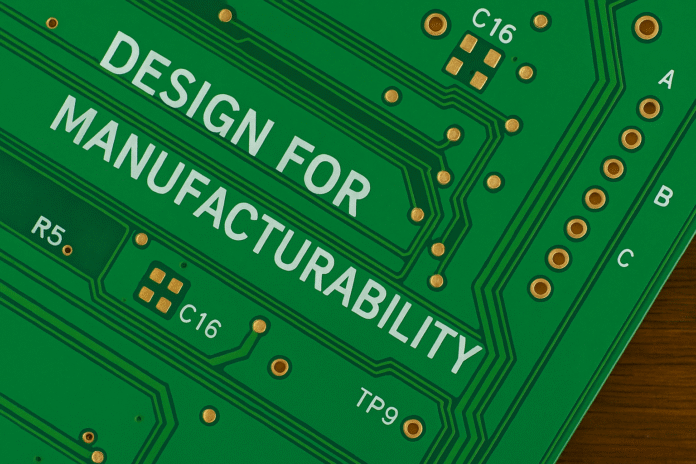DFM in PCB design is a foundational aspect of creating reliable, cost-effective, and high-yield electronic products. In modern electronics manufacturing, even the most innovative circuit can fail to reach production if it’s not designed with manufacturability in mind. Whether you’re designing a high-speed communication module or a compact consumer gadget, applying DFM principles early in the pcb design process helps minimize production issues, reduce waste, and keep costs under control.
This article focuses on the key concepts behind Design for Manufacturability (DFM) in the context of pcb design. We’ll explore design rules, fabrication considerations, layout strategies, and testing guidelines that contribute to a production-ready board. If your goal is to avoid last-minute redesigns, failed panels, and costly iterations, understanding DFM is not optional—it’s essential.
DFM in PCB Design
Design for Manufacturability (DFM) refers to the practice of designing printed circuit boards in a way that optimizes them for assembly, testing, and volume production. It involves aligning your design decisions with the capabilities and limitations of manufacturing processes, equipment, and tolerances. DFM helps identify design elements that may pose difficulties during fabrication or assembly, such as spacing violations, insufficient clearances, or parts that are hard to solder or place.
In pcb design, DFM spans across multiple domains—layout, component selection, via design, pad geometries, thermal management, solderability, and even silkscreen legibility. By incorporating DFM guidelines throughout the design cycle, engineers can reduce defects, improve yield, and shorten time-to-market.
When DFM is ignored, the result is often increased costs, rejected boards, and communication delays between designers and fabricators. When implemented properly, it results in robust, scalable, and repeatable products.
Design Guidelines for Manufacturability
Following well-established design guidelines makes your board easier to fabricate and assemble. These practices are not arbitrary—they’re based on decades of experience from PCB fabricators and assembly houses.
1. Trace width and spacing
Choose minimum trace widths and spacing based on the fabrication class and copper thickness. For standard 1 oz copper, many manufacturers recommend a minimum of 6 mil trace/space. Tighter tolerances raise production costs and risk.
2. Annular ring and via size
Via dimensions must provide enough copper around the hole to maintain electrical and mechanical integrity. Avoid microvias in standard boards unless absolutely needed. For through-hole vias, ensure the annular ring is at least 6 mil.
3. Minimum drill-to-copper clearance
Ensure that drilled holes are adequately spaced from adjacent copper to prevent shorts or etching problems. Most fabs require at least 10 mil clearance.
4. Solder mask expansion
Solder mask openings should be oversized slightly to avoid mask misregistration. This prevents mask slivers or blocked pads during assembly.
5. Pad-to-hole alignment
For through-hole components, ensure that the pad is properly centered around the drilled hole. Misalignment can cause soldering issues or open circuits.
6. Avoid acute angles
Copper traces that form sharp angles can trap acid during etching, weakening the trace or causing shorts. Maintain a minimum angle of 45 degrees in layout.
7. Standardize part footprints
Use standard, IPC-compliant land patterns for components whenever possible. Avoid overly customized pads unless there’s a specific reason.
8. Use fiducials
Fiducials are reference points used by pick-and-place machines. Include global and local fiducials to improve alignment and reduce placement errors.
9. Provide test points
Accessible test points make in-circuit testing and post-assembly inspection easier. Use labeled pads or through-holes that allow probing or automated testing.
Best Practices for DFM in PCBs
To make DFM a repeatable part of your design workflow, consider implementing these best practices:
Design with the fabricator in mind
Every PCB manufacturer has slightly different capabilities. Get a capabilities document from your fab and design within those limits. This includes trace widths, via types, layer stackups, and hole sizes.
Use standard layer stackups
Non-standard stackups often increase cost and complexity. Stick to common layer arrangements unless signal integrity or impedance control requires something custom.
Apply design rules early
Apply design rule checks (DRC) in your layout tool from the beginning, not at the end. This avoids repeated corrections and saves valuable time.

Validate with DFM tools
Many EDA tools (Altium, KiCAD, Eagle, OrCAD) provide built-in DFM checks. Additionally, third-party tools like Valor NPI, DFM Now, and free services from board houses can catch manufacturability issues before you submit Gerbers.
Plan component placement for assembly
Avoid placing components too close to board edges, connectors, or each other. Leave room for nozzles, soldering irons, and automated test probes.
Minimize via-in-pad
Via-in-pad designs can cause solder wicking, leading to poor connections. If necessary, use filled and capped vias, but expect higher fabrication cost.
Use consistent pad geometries
Ensure pad shapes and sizes match the components’ leads and solder expectations. Too much or too little pad area can cause tombstoning, insufficient solder, or bridging.
Leave silkscreen clearance
Don’t place silkscreen on pads or vias. Make sure reference designators are readable, placed away from solder joints, and not under components.
Orient polarized components uniformly
Keep all diodes, LEDs, and electrolytic capacitors facing the same direction to simplify inspection and reduce placement errors.
Panelization considerations
If your board will be panelized, leave edge clearance and add mouse bites or V-grooves according to fab house requirements. Consider tooling holes and break-off tabs if needed.
Importance of DFM in Electronics
Ignoring DFM can result in products that are too expensive or unreliable to produce at scale. In contrast, applying DFM principles leads to reduced errors, improved time-to-market, and consistent product quality.
Key benefits of DFM in electronics:
- Lower manufacturing costs: Designs that fit standard fabrication tolerances are cheaper to produce.
- Faster turnaround times: A DFM-optimized board sails through fabrication without manual interventions or clarifications.
- Higher yields: Better design leads to fewer defective boards and higher success rates during assembly.
- Improved field reliability: Good design choices result in better thermal dissipation, stronger solder joints, and fewer mechanical failures.
- Streamlined communication: DFM practices align designer intent with the expectations of the manufacturer, reducing back-and-forth communication.
As product complexity increases, so do the challenges in manufacturing. High-density designs, fine-pitch components, and RF features all require even stricter DFM controls.
How to Apply DFM in PCB Design
Applying DFM is not a separate stage—it’s a mindset that should be integrated throughout your pcb design process.
1. Communicate with your manufacturer early
Before finalizing your layout, get in touch with your fabrication and assembly vendors. Share your design requirements and ask for a capabilities document. Designing with real-world constraints in mind avoids surprises later.
2. Use fabrication checklists
Create or use DFM checklists to review pad sizes, drill charts, silkscreen placement, component spacing, copper clearances, and design rule settings before exporting Gerber files.
3. Simulate for manufacturability
If your design includes controlled impedance, high-speed lines, or sensitive analog signals, simulate the layout to check for reflections, crosstalk, and EMI. Make adjustments before final tape-out.
4. Collaborate across disciplines
Mechanical, electrical, and manufacturing teams must work together to align board dimensions, connector cutouts, and thermal constraints. Use 3D modeling and assembly previews when possible.
5. Document everything
Generate detailed fabrication notes, layer stack descriptions, drill tables, pick-and-place files, and bill of materials (BOMs). Label sensitive components, orientations, and keep-outs clearly.
6. Review and revise
A second set of eyes on your layout can catch mistakes you might miss. Conduct peer reviews or run your design through an automated DFM audit.
7. Use IPC standards
Refer to IPC-2221 (generic PCB design standards), IPC-7351 (land pattern standards), and IPC-A-600 (acceptability of printed boards) for design guidance that aligns with industry norms.
8. Don’t over-optimize too early
While shrinking everything may seem efficient, it’s often better to leave comfortable tolerances until your design is validated. Aggressive design rules increase risk without guaranteed payoff.
9. Keep the end-user in mind
DFM includes post-production handling and servicing. Will the board be easy to rework? Can components be replaced by hand if needed? Are test points accessible? These questions matter.
10. Use feedback loops
After each production run, gather feedback from the assembly house and QA team. Were there consistent issues? Did solder bridges occur on specific footprints? Use this feedback to improve future revisions.
Conclusion
DFM in PCB design is not just about avoiding errors—it’s about building better products. Whether you’re designing for prototype runs or high-volume production, following DFM practices allows you to minimize rework, maximize yield, and create reliable, scalable designs. The sooner you incorporate DFM into your pcb design process, the smoother your path will be from concept to final product. Good DFM doesn’t just benefit the fabricator; it ensures your designs are practical, testable, and successful in the real world.
